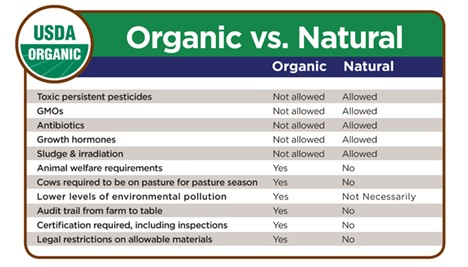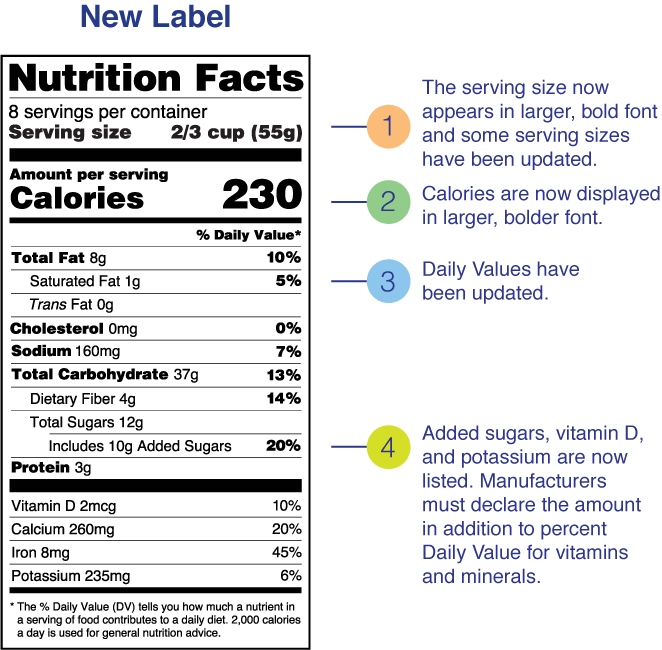by Alexandra Wickson & Amy Sharma
Our food packaging comes covered in labels: nutrition facts, expiration dates and sell-by dates, seals saying organic, all-natural, sugar-free, etc. But what do these labels actually mean, and are there actual requirements for these labels?
Who Regulates Food in the United States?
Food regulation in the United States can be complicated, but there are two main agencies that regulate food, the U.S. Department of Agriculture (USDA) and the Food & Drug Administration (FDA). These agencies also work closely with the Centers for Disease Control (CDC), which investigates foodborne outbreaks and with the Environmental Protection Agency (EPA), which approves pesticides and determines pesticide residue tolerance levels.
USDA regulates almost all meat (including beef, pork, poultry, and lamb) and egg products.
FDA regulates fish and seafood, whole eggs, fruits and vegetables, and most other foods (dairy, cereal, spices, legumes, etc.) The FDA also regulates food labels such as nutrition facts.
What is the difference between expiration and sell-by dates?
Federal law does not require any dates on products except for infant formula. Dates on products are added by manufacturers for quality purposes. Many factors can determine shelf life of a food such as packaging, storage temperature, whether the product is open, and the type of food.
| Common Labels | USDA Definitions* | Is it a date related to food safety? |
| Best if Used By/Before | Shows when the product will be at its best flavor or quality | No |
| Sell-By | Tells the store how long to display the product for sale | No |
| Use-By | The last date to use the product for optimal quality | No, except when used on infant formula |
| Freeze-By | When the product should be frozen by to maintain optimal quality | No |
Organic, Natural, Fat Free, Sugar Free, Non-GMO, Healthy - What Do These Labels Mean?
Some of these terms have strict definitions and others don’t, but even those with strict definitions are often misinterpreted.
Let’s start with organic, there are four different types of labels for organic, shown in the graphic below. Many people think organic means fewer or no pesticides, but organic farmers are allowed to use pesticides, as long as the pesticide is on the nationally approved list of pesticides maintained by the USDA. Typically, getting on this list requires the pesticide to be derived from a natural source, but there are a few exceptions. Although some research has shown that organic produce has less pesticide residue than conventionally grown produce, it’s important to note that just because a pesticide is naturally derived doesn’t necessarily make it safer than a synthetic version. To reduce pesticides (and germs) on any produce, you can scrub the produce under running water before cutting or eating it.

The term “natural” is used on a large variety of foods and has two different definitions.
The USDA, who regulates most meat, defines natural as “a product containing no artificial ingredient or added color and is only minimally processed.”
The FDA, who regulates most other foods, doesn’t have a formal definition or restrictions on use for “natural,” although they are working on defining this term. Currently, they’ve considered natural to mean that “nothing artificial or synthetic (including all color additives regardless of source) has been included in, or has been added to, a food that would not normally be expected to be in that food.” But they didn’t address any manufacturing methods or nutritional standards in their consideration of the definition.

There are many terms related to fat and sugar content in foods—fat-free, low-fat, reduced fat—but let’s talk about fat-free and sugar-free.
With fat-free and sugar-free, you should check the nutrients carefully. Some fat-free or low-fat foods have been found to have higher sugar amounts than full-fat options of the same food. Sugar-free foods often contain artificial sweeteners, which can help with weight control and diabetes, but has been shown to play tricks on taste receptors, which causes some people to overeat.
With any fat-free, reduced-fat, or sugar-free – check the ingredients and nutrition label to see what you are eating.
Genetically modified organisms (GMOs) are defined by the World Health Organization as “organisms (i.e. plants, animals or microorganisms) in which the genetic material (DNA) has been altered in a way that does not occur naturally by mating and/or natural recombination.”
The federal government has no labeling or true definition for non-GMO products. The USDA and FDA do have standards for third-party labels in that they cannot be misleading or untrue. The most common non-GMO label you will see is from the Non-GMO Project. The Non-GMO Project defines their label as: “the verification mark does not state that a product is ‘GMO Free,’ and it does not state that the product is safer, better or healthier. It simply states the product is compliant with the Non-GMO Project Standard.” The standard requires manufacturers using the label to adhere to systems and procedures that eliminate or reduce GMOs in their products.
The non-GMO labels arose from consumer demand and not from a federal requirement or suggestion based on safety or quality. Many people have concerns about GMOs because there are unknowns. With science, we can only draw conclusions on the information we have gathered, and no one in science is ever 100% sure of anything. The FDA has regulations and testing to ensure that food and medicine are safe. Products cannot go to market without meeting these standards. But the FDA also requires after-market studies to ensure the product is still showing to be safe as new evidence appears and more people use it. GMO foods are approved for sale, which mean they meet safety requirements. As with all food and medicine, research on GMOs is ongoing. So far, research has shown GMOs to be equal to non-GMO foods in safety, quality, and nutrition.
Studies have shown that GMOs can have some advantages for farmers or consumers. Examples of uses for modifications to crops includes: insect resistance, vitamin enrichment, herbicide tolerance, resisting browning or bruising, etc.
While the U.S. only has a few types of crops that are GMO, those that are GMO make up a huge percentage of the crop that is grown. For example, the FDA states that “in 2018, GMO soybeans made up 94% of all soybeans planted,” so if you eat any products made with soybeans, it’s very likely you are eating GMO crops. In fact, most GMO crops in the U.S. are used as ingredients in other products, although GMOs can also be used in clothing and medicine.
The entirety of the below is taken directly from Your Local Epidemiologist, The Dose (Jan 3, 2025), by Katelyn Jetelina
Well, just in time for the new year, FDA updated the definition [of healthy] to align with the latest science. (The last time this definition was updated for food labeling requirements was in 1994!)
Starting in February 25, 2025, if a company wants to claim their new food is “healthy” on a package, they must meet two requirements:
-
The food must contain a certain amount of one of the five food groups (fruits, vegetables, grains, proteins, dairy).
-
The food cannot exceed added sugar, sodium, or saturated fat limits based on the food and its customarily consumed amounts.
The changes remove limitations on total fat and cholesterol and the required provisions of vitamin A, vitamin C, calcium, iron, protein, and fiber—things that could simply be added to foods.
Basically, this updated definition aims to focus on more nutrient-dense foods, emphasizing food groups (and the overall nutrition profile) rather than individual nutrients in isolation. While this is progress in the right direction, it’s imperfect. For example, full-fat plain yogurt cannot be “healthy” under this guidance, but low-fat flavored yogurt with some added sugar could be.
What’s next? Reporting food as “healthy” is voluntary. Foods already on the market must comply by February 2028.
In the meantime, FDA is developing a “healthy” symbol that could be used for front-of-package labeling. While only time and research will tell how effective these labeling strategies are, it’s a step in the right direction, updating considerably outdated nutrition guidance, encouraging industry to reformulate foods, and making it easier for the public to make healthier choices.
Nutrition Facts Label
The FDA requires that most food sold have a Nutrition Facts label. This label lists things such as caloric content, vitamins and minerals, fibers, fat, and ingredients. This label is fact-based, lists the actual numbers related to what is in the food, and the ingredients are listed in the order of largest to smallest amount.
The Mayo Clinic has a guide to how to read this label. When making food decisions, this label is the most important in that it tells you what is inside the food and how that stacks up to nutritional guidelines.

Take Action and Learn More
Next time you make a food decision, skip the labels and head for the Nutrition Facts. Make your decision based on what is actually in the food, not on what advertisers think is important.
Learn more about food quality and safety:

